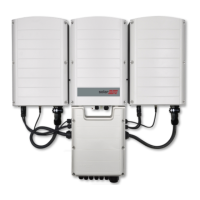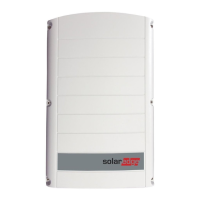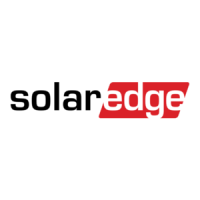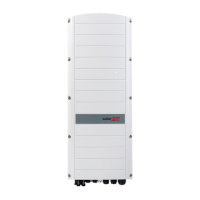Do you have a question about the SolarEdge SE120K and is the answer not in the manual?
Explains warning, caution, note, and important safety feature symbols.
Various warnings on injury, servicing, grounding, and inverter cover.
Opening and testing under power by qualified personnel only.
Safety Unit, isolated circuits, SafeDC voltage, and high voltage marking.
PVRSS incorporates equipment for rapid shutdown control and system requirements.
Servicing/replacing equipment requires following guide for system integrity.
DC-DC converters for maximizing power harvesting via MPPT.
Converts DC to AC power and receives monitoring data.
Notes and warnings for installing Power Optimizers.
Module connection, mounting, connector compatibility, and safety features.
Determining location, marking holes, and attaching optimizers to the rack.
Grounding optimizers on metal rails using star washer or plate.
Connecting positive and negative terminals of module to optimizer.
PVRSS limits and connecting optimizers in series, minimizing EMI.
Measuring PV string voltage and verifying polarity.
Instructions for vertical and horizontal inverter installation.
Over-current protection and PE wire connection before AC wires.
Connecting DC wires, ground wire, and ensuring correct polarity.
Steps to check successful connection to monitoring platform.
Steps for activating installation for on-grid commissioning.
Verifying firmware, status, and LED indicators.
Items and steps for pre-commissioning without grid connection.
Methods for identifying errors using LEDs and monitoring platform.
Malfunctions and corrective actions for Power Optimizers.
Troubleshooting high PV string voltage issues.
Troubleshooting Ethernet (LAN) and RS485 communication issues.
Performing yearly inspection and visual checks of the inverter.
| AC Frequency | 50 / 60 Hz |
|---|---|
| Inverter Topology | Transformerless |
| Cooling Method | Forced Air |
| Rated Output Power | 120 kW |
| Maximum DC Voltage | 1000 V |
| Cooling | Forced air |
| Operating Temperature | -25°C to 60°C |
| AC Voltage | 400 Vac |
| Communication Interfaces | RS485, Ethernet |
| Operating Temperature Range | -25 to +60°C |
| Model | SolarEdge SE120K |











